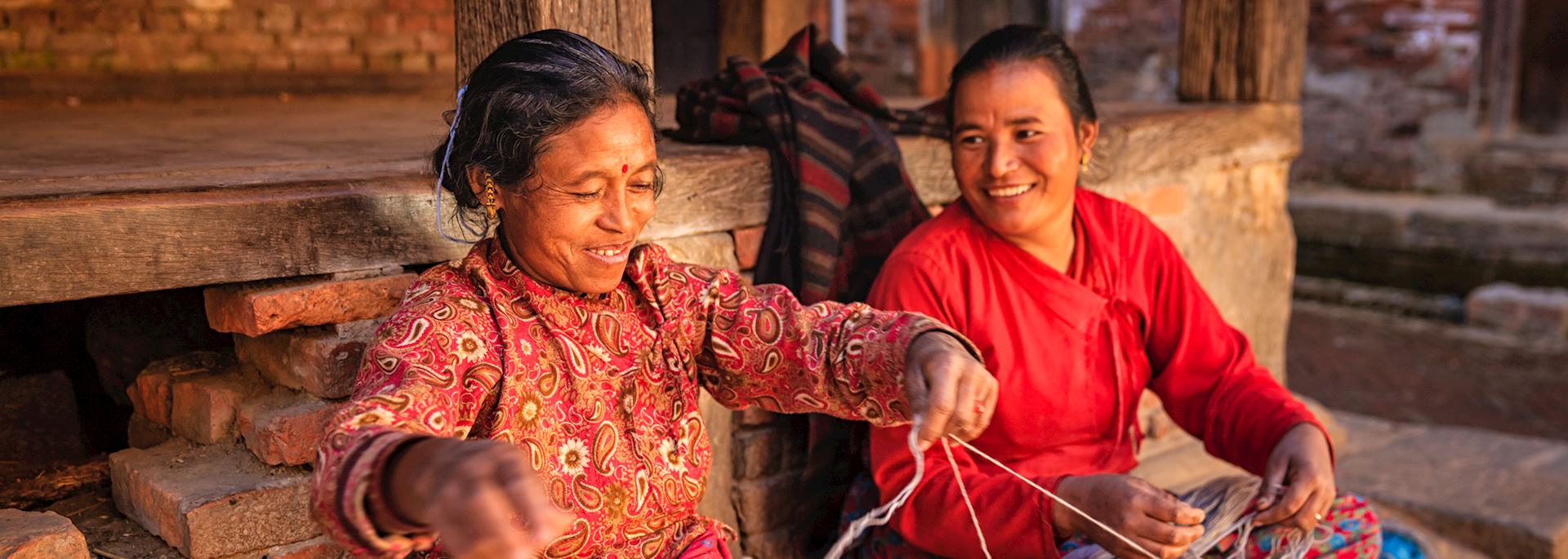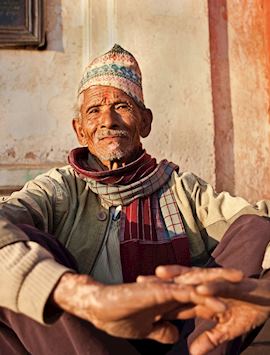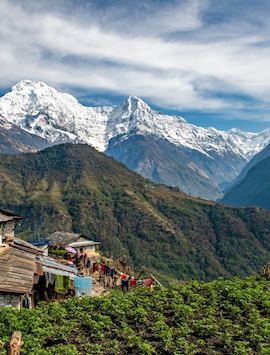By India specialist Sophie
When I first arrived in Kathmandu, I was struck by the people: so warm and giving. The Nepalese seem so at peace, a state of mind I’m convinced is connected to living in the ever-present Himalaya.
India’s gentle cousin, Nepal runs at a slower pace — after all, most people travel on foot. The country is a Mecca for trekkers, but you don’t have to don hiking boots to enjoy Nepal properly. There are monasteries and medieval towns to wander and jungles and rivers to explore.
Kathmandu
As you fly into Kathmandu, you pass the rippled valleys and peaks of the Himalaya before lowering into the bowl-shaped Kathmandu Valley. Compared with other Asian capitals, Kathmandu is tiny, but its narrow streets and low-rise buildings are filled with enough sights to keep you there for a few days. It may be small, but over a million people live in the city, its streets busy with foot-traffic, markets and scooters.
Explore Kathmandu’s temples
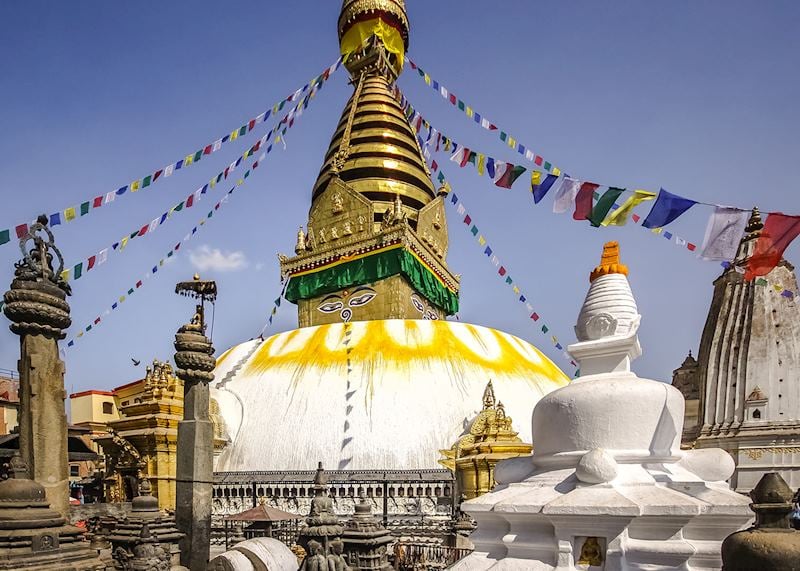
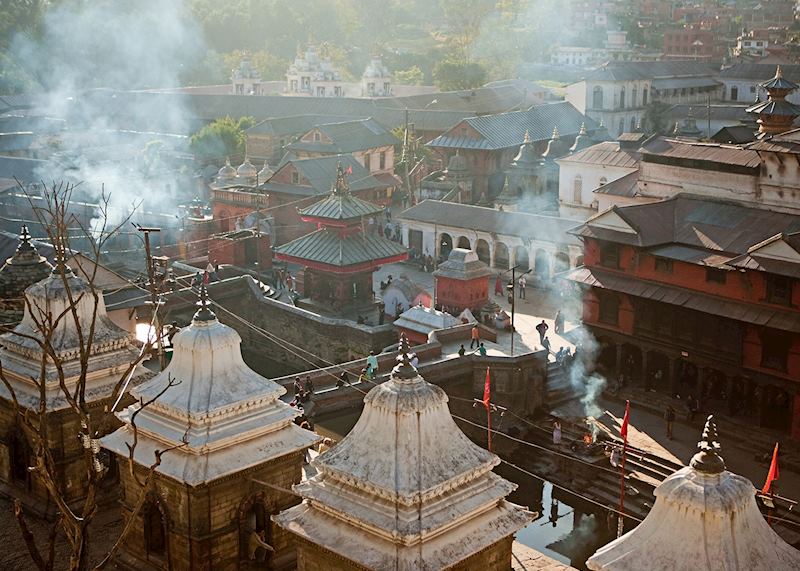
Get your bearings — and stretch your legs — by walking the 365 steps to the Swayambhunath Temple, which tops a hill to the west of Kathmandu. It’s nicknamed the ‘monkey temple’ in reference to the cheeky langurs that scoot past as you make your way up.
The temple complex is a conglomeration of Buddhist and Hindu architecture, alongside a Tibetan monastery. The pinnacle of the hill is marked with a figurehead white and gold stupa, and the haze of heavy incense and oil lamps. Look below, beyond the sea of flickering prayer flags, to see right across the city.
On one evening in Kathmandu, I headed to the eastern outskirts of the city to visit the Pashupatinath Temple. A UNESCO World Heritage Site, this is the most important Hindu site outside India: a collection of temples, ashrams and ghats, guarded by a huge bronze Nandi (the bull servant of Lord Shiva).
Arriving in time for evening prayers, I could see the fires from the burning ghats reflected in the Bagmati River, which runs alongside. The funeral pyres are in constant use, with family funerals taking place every day.
Celebrate a festival
Like next-door India, Nepal celebrates public holidays and festivals with enthusiasm. It’s worth checking if any events fall during your travel dates.
The five-day Hindu festival of Tihar, Nepal’s festival of light, is celebrated annually across the Himalaya, usually falling in October. Each day celebrates something held in reverence by the Nepalese, including dogs, crows and cows, cow dung (essential for cooking) and the relationship of brothers. Porches are decorated with bright rice and petals, and villages lit with rows of oil lamps.
Where to stay in Kathmandu
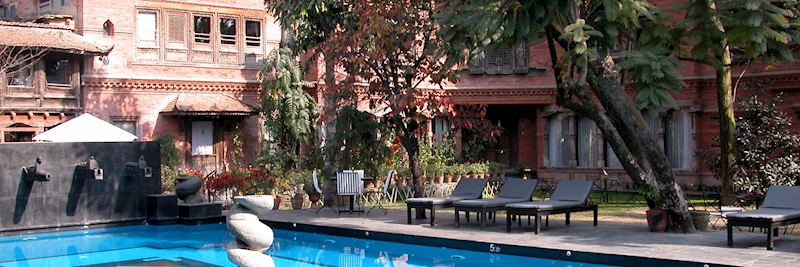
There are plenty of choices of accommodation in Kathmandu, but one I recommend frequently is the Dwarika’s Hotel. The founder of Dwarika’s Hotel, Dwarika Das Shrestha, began to notice that wooden parts of disused buildings and temples, carved with intricate Newari (a culture native to the Kathmandu Valley) motifs, were being burned for firewood. He started to buy up the abandoned pieces of wood and built Dwarika’s Hotel out of the preserved sections. Balustrades of carved wood edge the hotel’s balconies and every window is extravagantly framed.
Almost everything in the rooms has been handmade in Nepal, much of it in the hotel’s own workshop (and available to buy in the hotel’s shop). The swimming pool and spa are a particularly good antidote after a busy day exploring.
Kathmandu Valley
From Kathmandu, you can head out to explore the surrounding towns, villages and walking trails of the Kathmandu Valley.
Bhaktapur

The tiered stupa and streets of traditional red-brick houses in Bhaktapur are considered among the best preserved in Nepal. The earthquake of 2015 pulled down many of the buildings, but the subsequent relief effort assisted a swift recovery and by visiting you can inject more money into the community.
Bhaktapur is a quieter, smaller version of Kathmandu, set around three temple squares. Take some time to wander the streets and you’ll notice that almost every doorway and window is framed with carved peacocks and Hindu gods. The best examples are in Durbar Square on the façades of the 55-window Palace, which was once the seat of Nepalese royalty — it now houses the National Art Gallery.
Around each square you’ll find tiny local restaurants — usually just one or two rooms. Sweet Home Bhaktapur, just off Durbar Square, cooks particularly good momos (a steamed dumpling usually filled with pork or vegetables).
The town is only 30 minutes’ drive from Kathmandu’s international airport, making it a convenient alternative to Kathmandu before you fly home.
Trekking in the Kathmandu Valley
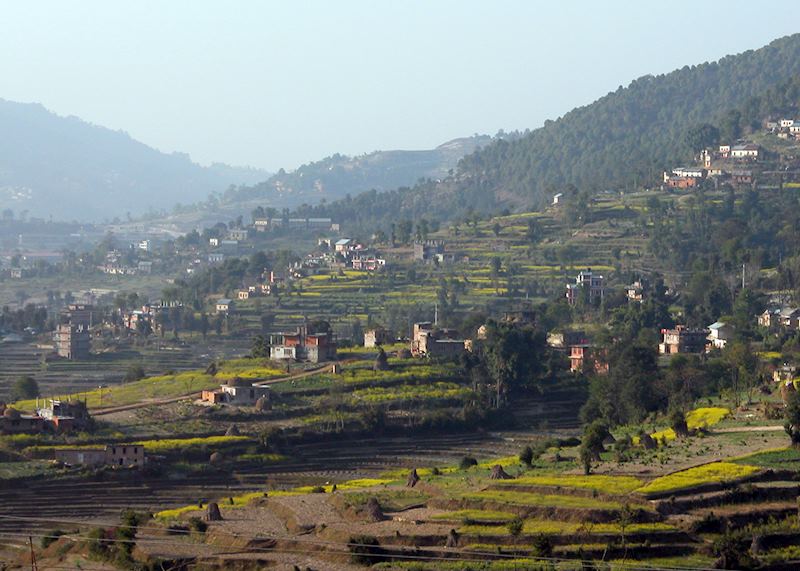

Below Nepal’s celebrity peaks, you’ll find pine-capped hills, well-tended farmsteads and medieval villages. Low-altitude trekking routes through the Kathmandu Valley take in a variety of landscapes and offer the flexibility to walk for a couple of hours, or tackle something longer.
Staying at Namobuddha Resort in the south of the valley, I was well located to embark on a few days of gentle trekking. The hotel is owned by a German family, who’ve embraced everything Nepalese with a firm eco-friendly stance. Staff can show you around the property’s organic farm and introduce you to the cow herd.
My guide and I left one morning to walk to the nearby medieval village of Dhulikhel. The route was relatively gentle, passing through hamlets of wooden houses and smallholdings growing vegetables.
We took a small detour to the Namo Buddha, a stupa which was bright with prayer flags. We arrived in Dhulikhel three hours later, the clouds clearing to give us a view across the eastern Himalaya. We were invited into the home of a local Newari family for lunch before being driven back to the hotel.
The Namobuddha Resort is a collection of mini Nepalese houses, whose carved woodwork was crafted by local carpenters. You’ll have a house with a small lounge and outdoor courtyard to yourself. There’s no Wi-Fi or TV: instead, guests are invited to drinks around the fire on the terrace at 7pm each evening.
- For more trekking options, take a look at our guide: Nepal trekking: walking on the roof of the world
Bandipur

Nepal’s roads are bumpy, so it’s worth adding in a few overnight stops to break up long journeys. The village of Bandipur is west of Kathmandu and halfway to Pokhara, Nepal’s second-largest city. It’s both a convenient stop and worth setting some time aside to explore.
My guidebook described the town as an open-air museum, and I’d agree. On the trade route to Tibet, Bandipur was a prosperous trading post until the border closed. While the markets are now aimed at visitors, it feels like little else has changed. Tall Newari mansions with elaborately carved shutters are set around a main bazaar, which sells rice, maize and feathery bunches of herbs.
Most Nepalese cafés are furnished with bright plastic chairs and tables. In the cafés of Bandipur on the other hand, you’ll see residents sat around antique teak dining tables on matching chairs. Street and shopfront signs are hand-painted and you won’t see a car all day as the central streets are for pedestrians only.
Chitwan National Park

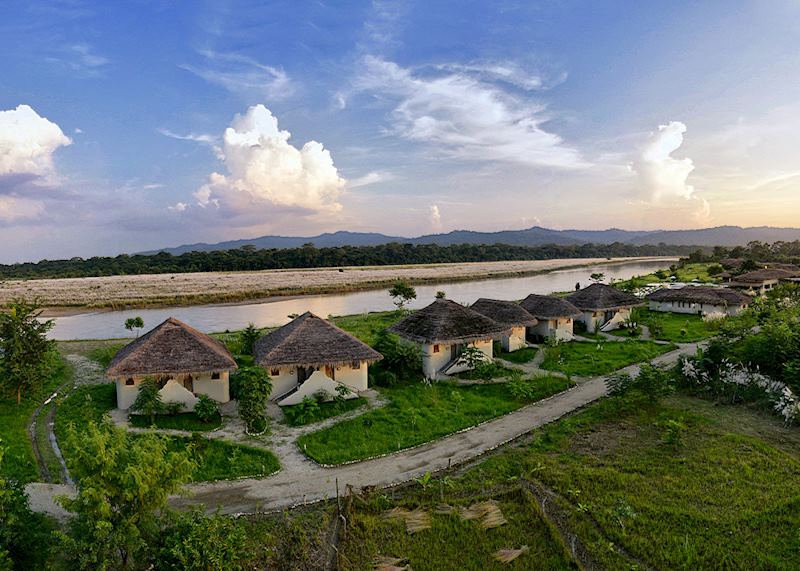
On the way to Pokhara, you can add a detour to Chitwan National Park, a three- to four-hour drive from Bandipur. The park is a blend of forest, marshland and grassy plains, intersected by the Rapti River and its tributaries. You have an excellent chance of seeing one-horned rhinos, moneys and deer, as well as birds (over 500 species inhabit here).
Leopards, elephants, sloth bears and a growing population of Bengal tigers are in the vicinity, though hard to sight.
On a jeep safari, you’ll regularly see your guide or tracker listening for the warning calls that announce the arrival of an animal. Chitwan National Park was the first park quiet enough for me to hear the squawks and screeches myself.
Exploring on the Rapti River by boat, in the western part of the park, I didn’t see another visitor all day. The splashing of water nearby alerted us to the presence of a one-horned rhino taking a bath, a number of bird species hovering close by.
Where to stay in Chitwan National Park
Most hotels are located in Sauraha, a village on the northern banks of the Rapti. It can feel very busy, and when you head into the park you’ll be one of many. As an alternative, I suggest journeying farther west along the river to Barahi Jungle Lodge, a comfortable stay on a much quieter part of the river.
At Barahi, you’re assigned your own naturalist who’ll help you plan your activities — a choice between boat or jeep safaris, or exploring on foot. My naturalist joined me for lunch to discuss ideas for the days ahead. There’s also an eco-friendly focus here, with paper made from rhino dung, furniture made from recycled bamboo and locally sourced mud coating each cottage’s walls.
Pokhara
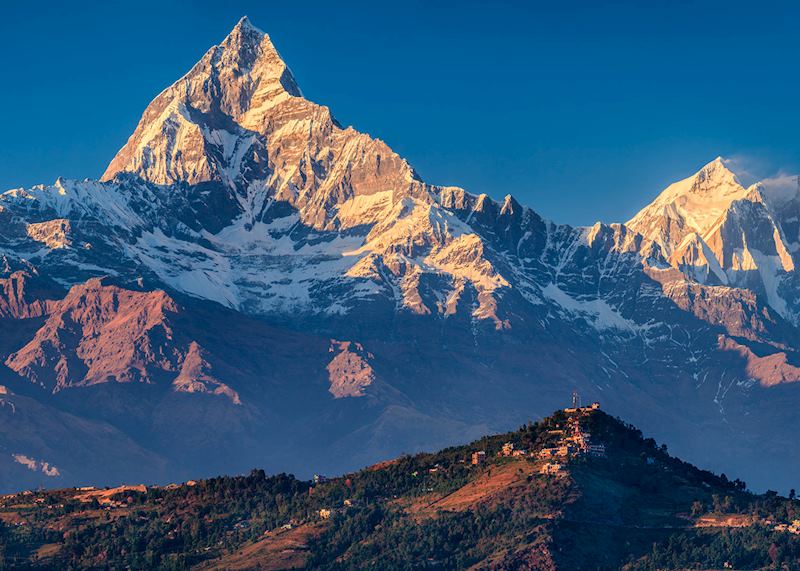
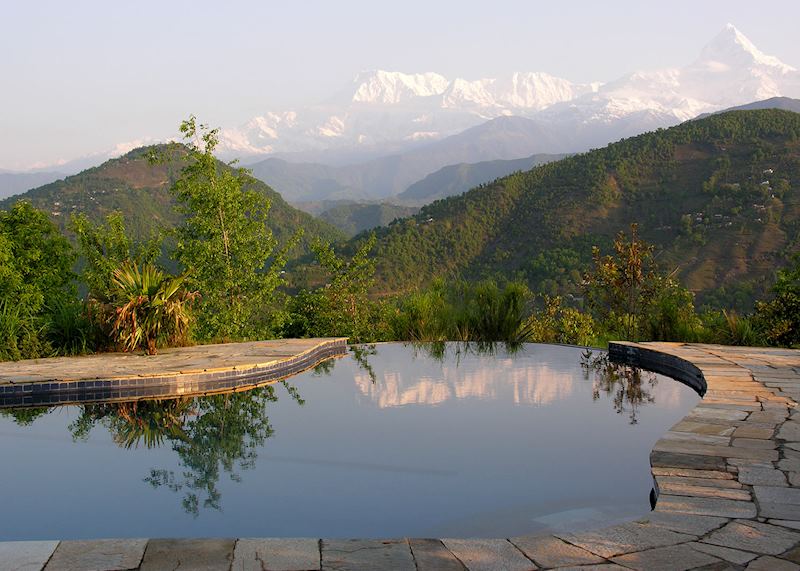
Set in a basin on the shores of Lake Phewa, Pokhara is surrounded by some of the world’s highest peaks. Machapuchare (nicknamed ‘Fishtail Mountain’ for its two-peaked summit) dominates the skyline, its pointed profile particularly striking against the lower peaks. It’s one of the few unclimbed mountaintops in Nepal as the government has deemed it sacred, banning any ascents. Hindus believe that Lord Shiva lives on the summit and often pilgrimage to the foot of the mountain.
Pokhara is used by climbers and mountaineers as a gateway to the Annapurna mountain range, but it’s also a great place simply to relax and soak up the mountain views. There are massage salons for rejuvenating tired legs — Nepalese massages are rather firm in comparison with others — as well as small restaurants and handicraft stalls selling locally weaved textiles.
If you’re not tackling a longer trek or hike in Nepal, Pokhara is a good base for shorter day treks. Early one morning, my guide and I hiked three hours uphill to Sarangkot at 1,610 m (5,282 ft), a small village set high on a ridge overlooking the city. From there you can see right across Pokhara Valley as the land sweeps up to meet the forested foothills with the icy peaks above.
I also had the chance to trek through some of the surrounding rural villages, on a route tailored by my guide. We were welcomed into many homes along the way, including one which had been converted into a tiny museum housing a collection of Nepalese furniture, crockery and goblets. We were also invited to watch the preparation of raksi, the local liquor brewed from rice. I couldn’t handle the pungent taste, but my guide seemed to enjoy himself.
Where to stay in Pokhara
From my window at Tiger Mountain Lodge, Pokhara, I could see five of the world’s eight highest peaks. The lodge is set on a ridge about 40 minutes’ drive from Pokhara, and built to resemble a local village with low-rise cottages surrounding a central courtyard. The staff will take you on nature walks around the lodge, and the facilities include an infinity pool.
Gorkha

Journeying back from Pokhara to Kathmandu, I stopped at Gorkha. Rarely mentioned in guidebooks or included in well-trodden routes through the country, it’s important to the Nepalese as the birthplace of Prithvi Narayan Shah, who unified the kingdoms of Nepal in 1769. As always, the Himalaya are in the background, and the village felt particularly remote in its cloak of dense forest.
There was a tiny museum on the unification of Nepal and, looking through the visitors’ book, few make it out here. It’s a part of the country that tourism hasn’t quite reached, although my hotel, Gorkha Gaun, 12 cottages set into the hillside, provided a comfortable stay.
Start planning your trip to Nepal
Start thinking about your experience. These itineraries are simply suggestions for how you could enjoy some of the same experiences as our specialists. They're just for inspiration, because your trip will be created around your particular tastes.
View All Tours in Nepal
